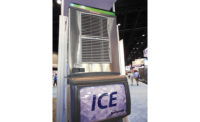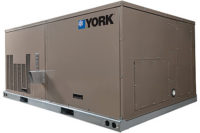The most commonly heard three-letter term in the ice machine business used to be “ice.” Now, it has been joined by “EPA” and “DOE,” which both are garnering as much attention as the actual end products.
The U.S. Environmental Protection Agency (EPA) is in the process of phasing down a number of popular hydrofluorocarbon (HFC) refrigerants, including ice machine stalwarts R-134a and R-404A. Meanwhile, an even more pressing issue looms from the U.S. Department of Energy (DOE): new efficiency standards are due to take effect Jan. 1, 2018, and increase ice machine efficiency requirements by roughly 20 percent.
The DOE’s intentions are laudable. The new standards are projected to result in approximately $2 billion in energy bill savings for products shipped between 2018 and 2047 and is anticipated to avoid about 11 million metric tons of CO2 emissions. However, with product lines being redesigned even as this is being written, this will certainly not be an easy task for ice machine manufacturers.
“With the DOE’s new energy standards for maximum energy use by commercial ice machines poised to take effect in January 2018, the push for energy efficiency is now not just a trend but a necessity,” said Ani Jayanth, marketing manager, foodservice, Emerson Climate Technologies Inc. “These standards will require between 15 and 25 percent energy reductions in kWh per 100 pounds of ice produced, and, based on the standards, approximately 60 percent of ice machines currently listed in the DOE database will not meet that requirement.”
According to Jayanth, Emerson’s efforts have been focused on optimizing the compressor, particularly as it relates to the harvest cycle.
“The technical challenge lies in increasing efficiency levels to meet new energy standards and maintaining or even improving ice machine operational steps to produce appropriate quantities of ice, and we have been working to raise those efficiency ratios to meet these requirements,” Jayanth said.
DOE STANDARDS A TOP PRIORITY
When it comes to the EPA and DOE’s combined moves, the DOE’s energy-efficiency requirements are the first priority for ice machine manufacturers, said Scott DeShetler, director of marketing, Ice-O-Matic.
DeShetler said the new efficiency rules have Ice-O-Matic and all other ice machine manufacturers working hard to redesign their equipment.
“The new DOE rules will increase the energy-efficiency requirement by about 20 percent for everyone in the industry,” he said. “And, although we’re all redesigning with an eye toward new refrigerants, we won’t be fully impacted by the EPA rulings until 2020, so our more pressing issue in the ice machine business is to address the DOE regulations.”
Meanwhile, the refrigerant issue promises to provide fuel for some interesting discussions and decisions over the next five years.
“Refrigerant issues are fairly complex for ice machines,” DeShetler said. “If we wanted to go to R-290 today, we wouldn’t be able to because the EPA has not yet approved R-290 for ice machines. It’s in the latest SNAP [Significant New Alternatives Policy] proposal, and it will be approved, but even then it will be controlled by charge limitations from the Occupational Safety and Health Administration [OSHA] that will limit R-290 systems to less than 400 pounds of production per day. Since most people buy machines bigger than that, we’re evaluating alternative refrigerants for our larger units.”
DeShetler also discussed Ice-O-Matic’s new ozone-delivery system, the O3-Matic, which infuses ozone into incoming water, killing microbes on every surface it touches and retarding future growth. In addition, the ozone becomes entrapped in the ice cubes, carrying the same sanitation benefits to the bin and dispenser. According to Ice-O-Matic, introducing ozone increases intervals between sanitizing and impedes microbial growth while continually sanitizing the ice making system, which diminishes mold, mildew, bacteria, and viruses. The O3-Matic is designed for modular cube ice makers and can be retrofitted to all existing units.
“The water is the most effective way to deliver ozone into an ice machine,” DeShetler said. “The O3-Matic doesn’t eliminate the need to sanitize and delime an ice machine, but it does extend the amount of time between the sanitation intervals and makes cleaning easier because there will be less buildup.”
ADDRESSING WATER QUALITY
Scott Bingham, senior product marketing manager, Follett LLC, said a growing trend in the ice machine industry is the focus on improving equipment reliability in applications with poor water quality. Removing total dissolved solids (TDS) from the water in the machine not only makes for better ice, it also helps keep machines cleaner and easier to maintain. Follett’s new Horizon Elite models now feature a system that isolates and regularly flushes TDS.
“Depending on what types of solids are in the water, TDS may cause scale buildup, have corrosive effects, and can impact the taste of the water,” Bingham said. “We have found that by regularly quarantining and dispelling the TDS, we can greatly reduce or eliminate scale buildup between the normal sanitizing periods. In addition, the method is very inexpensive as it uses only a very small amount of flush water.”
The system was voted as a product innovation of the year runner-up by the Foodservice Consultants Society Intl. and received a Kitchen Innovation Award from the National Restaurant Association.
Bingham added that Follett is exploring its refrigerant options and watching for the industry to determine a direction in this area.
“We’ve done some explorations with R-290, but there are issues with building codes and with technicians not yet really being ready to handle -290,” Bingham said. “The market will need to coalesce and determine what direction we’re going. We’re not going to dictate the direction of the industry — it’s going to have to be a collaborative effort.”
Finally, Bingham pointed out that the DOE’s new energy-efficiency regulations, in many cases, will be more stringent than the current Energy Star targets, and Energy Star is a voluntary program while the DOE regulations are mandatory for sale of the equipment in the U.S.
“The upcoming DOE regulations are an important consideration for those buying ice machines,” he said. “I’m happy to say all of Follett’s equipment already meets those 2018 standards today.”
ICE A ‘FAST FOLLOWER’ ON REFRIGERANTS
Bo Erickson, vice president of sales and commercial distribution, Manitowoc Ice, said the company will be using a three-prong approach when it comes to refrigerants going forward: R-404A will still be used for now, R-290 will be used in smaller units, and R-410A will gradually replace R-404A in larger units.
“We can still go with R-404A, but, eventually, that’s not going to be an option anymore,” he said, referring to the EPA’s phasedown of HFCs. “The good news is we can get some very good efficiencies out of R-410A in ice machines.”
The ice machine industry is fortunate to be a “fast follower” of the refrigeration industry on the refrigerant transitions, Erickson added.
“There is a lot of crossover as far as the technicians and the training between the refrigeration and ice machine businesses,” he said. “So, because our industry is not the first, we get the benefit of the work that’s already been done.”
Meanwhile, the DOE’s upcoming efficiency standards will impact a large number of all the ice machines on the market. According to Erickson, between 50 and 70 percent won’t meet the new threshold.
“We have some things to do to our machines to make sure they’re updated and ready for that, but we have plenty of time, and we have the technology to do it,” Erickson said.
From Manitowoc’s perspective, the company will continue to offer machines designed around easy cleanability. Erickson said about 60-70 percent of all problems with ice machines are attributable to lack of cleaning or maintenance, and Manitowoc’s machines are designed to be fully cleaned in about 45 minutes. This savings on maintenance time is one of the reasons the company’s machines have a low cost of ownership.
“We’re not the least expensive units, but we have a good payback story,” Erickson said. “It’s our biggest differentiator in the marketplace.”
Erickson concluded that Manitowoc is looking to aggressively target the health care market.
“Health care is a huge market, and although we have a large share of the ice machine market overall, we have a very small percent of the health care market,” he said. “Increasing our share of that market is a huge focus.”
UNDERCOUNTER SQUARE CUBER
Hoshizaki America Inc. recently unveiled the IM200, a large square-cube ice machine designed to fit under counters.
“The large square ice cubes are designed to provide the perfect amount of chill for cocktails in upscale bars and restaurants,” said Sally Ray, marketing manager, Hoshizaki.
The IM200 has the capability of producing up to 200 pounds of ice per day, and a storage capacity of about 50-75 pounds.
“We‘ve offered the large square cubes in our 500-pound ice machines for a few years, but the new undercounter IM200 is perfect for bar areas,” Ray said. “Our hard, clear, dense ice cubes not only look good, they melt very slowly so they don’t dilute expensive drinks,” she said.
NEW INNOVATIONS
Fresh-Aire UV’s Ice UV Mini™ is an ultraviolet light system designed to eliminate biological contaminants in compact countertop ice flakers and water dispensers used in the health care industry.
According to Fresh-Aire UV, the dark and moist interiors of nursing station countertop ice flakers provide an optimal environment for unsanitary slime, mold, bacteria, and virus growth that may result in contaminated patient ice and failed health code inspections. The Ice UV Mini’s ultraviolet germicidal irradiation is designed to work silently 24/7 to eliminate slime and other biological contaminants from condensate drains and other countertop ice and water dispenser interiors. Fresh-Aire UV says its 254-nanometer UV-C lamp has a low-intensity discharge that won’t damage sensitive ice flaker plastic or metal internal parts. It is designed to fit in the tight interiors of most flaker brands and models.
In addition to sanitation, the Ice UV Mini, according to Fresh-Aire UV, will reduce ice machine cleaning and maintenance time and costs.
Danfoss recently introduced the universal TU ice machine service kit. The kit is designed to enable contractors and technicians to perform almost any thermostatic expansion valve (TXV) repair in an ice machine. The kit includes:
• An exchangeable orifice TU valve, type TUA, which Danfoss says can easily replace any OEM-specific TXV;
• A selection of orifice sizes covering ice machines ranging 75-2,300 pounds of ice;
• Elbow connections;
• A bulb strap; and
• Insulation tape.
Danfoss reps said that, while OEM-specific replacement parts will always best match OEM design performance, this new universal service kit may help deliver ice to end users hours earlier than otherwise possible and allows contractors to use the time saved on another job.
Publication date: 7/4/2016
Want more HVAC industry news and information? Join The NEWS on Facebook, Twitter, and LinkedIn today!










